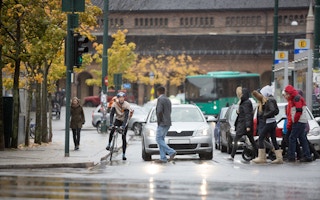How did you get to where you need to be today? Car, bike, public transport, or perhaps walking?
Transport is one of the biggest sources of greenhouse gas emissions, globally and in Australia. The latest IPCC report finds transport accounted for around 14% of global greenhouse gas emissions in 2010. The latest figures in Australia show transport contributed to 17% of Australia’s greenhouse gas emissions in 2013.
The good news is that by altering our behaviour, we can choose modes of transport that emit less greenhouse gases.
Measuring sustainability
When it comes to environmental sustainability, the obvious way to measure this is through the emissions that various modes of transport emit. Gross data such as the above examples show that road-based modes like lorries, buses and cars emit the most greenhouse gases, accounting for over two-thirds of the transport total in the EU. It would be easy then to assume that modes such as rail are the greener option.
“
The discussion thus far has focused on emissions and operations. But it is important to remember that the environmental sustainability of the transport system as a whole is most important
But the real measure comes from how energy-efficient a particular vehicle is as it carries a person a particular distance. Noted transport sustainability researcher David Banister calculates relative amounts of energy that different modes of transport consume, but adjusts for carrying capacity (maximum number of passengers the vehicle can accommodate) and the distance each passenger is carried on average. By taking the number of passengers and dividing it by the distance they are carried, Banister has calculated the megajoules consumed “per passenger kilometre”.
For obvious reasons, cycling and walking are hands-down winners in energy efficiency (and hence pollutants). They consume 0.06 and 0.16 megajoules per passenger kilometre travelled respectively. However these modes of transport obviously only carry limited passengers per “vehicle” (usually one) over relatively small distances.
What comes next is interesting: tram light rail is the next most efficient (0.91), with the bus coming in just behind (0.92). It beats heavy rail (based on London Underground, 1.69), and rail electric and diesel (1.65). This includes all other passenger rail: that which runs on electricity — most light rail — and that which runs on diesel fuel.
Motorcycles come next (1.73), followed by cars (2.10), Boeing 727s (2.42), and lorries and taxis (2.94). This ordering is roughly confirmed by other sources such as the European Energy Authority.

But in the real world…
In an ideal world, the ranking above stands. But in the real world how we actually use transport significantly affects sustainability.
For example, full buses travelling longer will be significantly more efficient in relative terms than empty buses travelling short spans.
Operating conditions for vehicles, such as stop-and-start traffic conditions and weather, all affect efficiency and there can be wide variation for a given mode of transport across different cities.
The source of fuel is also very important. Banister, amongst others, argues that Electric Vehicles (EVs) using electricity generated by renewable (e.g. solar) rather than coal or other carbon based fuel, may well become the most green of modes in future, even for single occupancy travel.
Additionally, the rise of car-sharing and other capacity sharing will, if widely adopted, decrease passenger kilometre measures of emissions for motorised vehicles.
More to sustainability than emissions
The discussion thus far has focused on emissions and operations. But it is important to remember that the environmental sustainability of the transport system as a whole is most important.
For example, different modes of transport need to be environmentally assessed across their whole life-cycle from production through operation to decommissioning and disposal. “Externalities” other than emissions need to be included (e.g. the amount of land needed for car parking, and noise).
Of course freight movement as well as passenger travel also needs to be examined (see detailed data on both for Australia here). There are many potential measures of such things but there is still a long way to go to filling these measures in.
To completely determine what is the most “sustainable” way to travel, we must also look at things other than just environmental sustainability. In its broadest sense, “sustainable transport” is the the ability of a total transport system to maintain itself over time. This includes financial, economic, social, community and environmental aspects.
If a transport system fails on any of these particular dimensions, it can be said to be unsustainable; sooner or later it will require significant external intervention to keep functioning. A transit system may carry passengers cleanly and efficiently, but if there are growing pockets of disadvantaged people who cannot readily access transit, one could say the system is “socially” unsustainable.
The bottom-line is that there needs to be more “active” travel (walking and cycling) and mass transit for a more sustainable transport system. And one should not have a blanket bias against motorised road modes of transport, such as buses. These can be a cost-effective part of any policy solution and can be greener than some might think.
What we really need is better land-use planning to reduce the need for more transport. Because ultimately, the most “sustainable” travel option is to have less travel overall.
Cameron Gordon is an Associate Professor of Economics at the University of Canberra and has an ongoing appointment as a Principal Investigator at the University Transportation Research Center (Region 2) in New York. This post originally appeared in The Conversation.

















